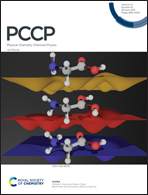Exploring the transition of polydopamine-shelled perfluorohexane emulsion droplets into microbubbles using small- and ultra-small-angle neutron scattering†
Abstract
Perfluorocarbon emulsion droplets are interesting colloidal systems with applications, ranging from diagnostics and theranostics to drug delivery, due to their controllable phase transition into microbubbles via heat application or acoustic droplet vapourisation. This work highlights the application of small- and ultra-small-angle neutron scattering (SANS and USANS, respectively), in combination with contrast variation techniques, in observing the in situ phase transition of polydopamine-stabilised perfluorohexane (PDA/PFH) emulsion droplets into microbubbles during heating. Results show peak USANS intensities at temperatures around 90 °C, which indicates that the phase transition of PDA/PFH emulsion droplets occurs at significantly higher temperatures than the bulk boiling point of pure liquid PFH (56 °C). Analysis and model fitting of the SANS and USANS data allowed us to estimate droplet sizes and interfacial properties at different temperatures (20 °C, 90 °C, and 20 °C after cooling), giving valuable insights about the transformation of these polydisperse emulsion droplet systems.



 Please wait while we load your content...
Please wait while we load your content...